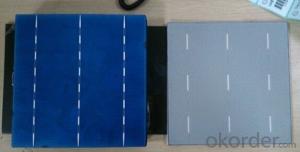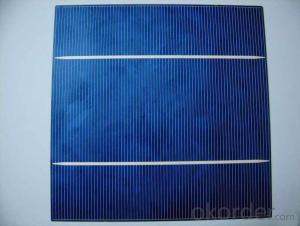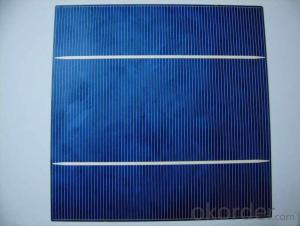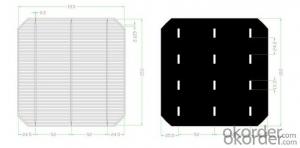156*156mm 3BB Mono-crystalline Silicon Solar Cell
- Loading Port:
- China main port
- Payment Terms:
- TT OR LC
- Min Order Qty:
- 100 watt
- Supply Capability:
- 10000 watt/month
OKorder Service Pledge
OKorder Financial Service
You Might Also Like
156*156mm 3BB Mono-crystalline Silicon Solar Cell
Solar Module Summarize
Solar Module is the core part of solar PV power systems,also is the highest value part of it. The function of Solor Module is to convert the sun's radiation to electrical energy, or transfer it to battery and store in it, or to drive the load running.
The Product has been widely used in space and ground, it mainly used for power generation systems, charging systems, road lighting and traffic signs areas. It could offer a wide range of power and voltage, and with high conversion efficiency, and long service life.
Dimension | 156mm X 156 mm ±0.5mm |
Wafer Thickness | 200um ±30um |
Front(-) | Four 1.1mm wide bus bars(silver) with distance 39mm, Acid texturized surface with blue silicon nitride AR coating. |
Back(+) | 2.4mm wide silver/aluminum soldering pads, aluminum back surface field. |
Product Show
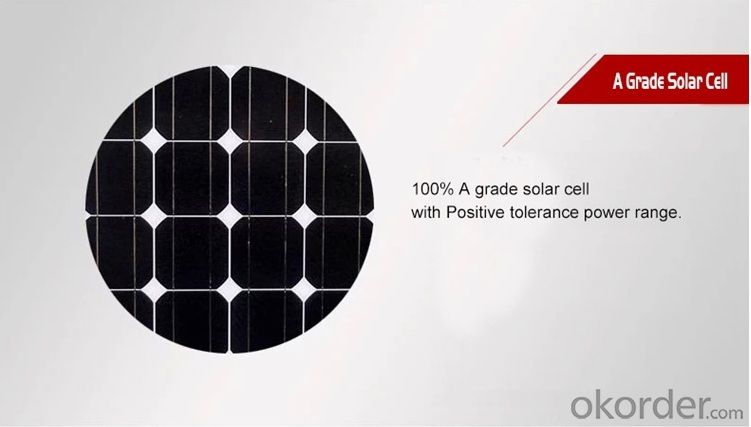
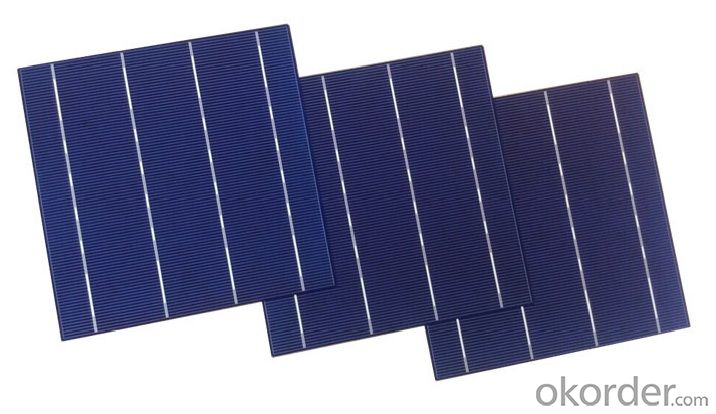
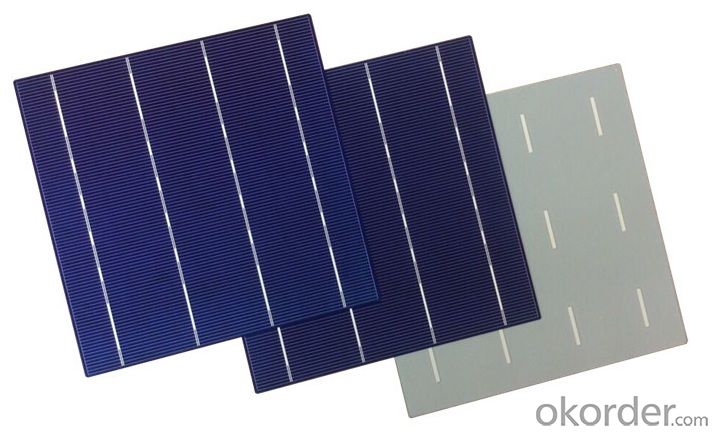
Package
Typical package for one carton contains 1,200 cells. The cells are sealed in cell box every 100 pcs.
Gross weight per unit carton shall be around 16.4kg.
- Q:What is the expected degradation rate of solar silicon wafers over time?
- The expected degradation rate of solar silicon wafers over time varies depending on various factors such as the quality of the silicon material, manufacturing process, environmental conditions, and maintenance practices. However, on average, silicon solar wafers experience a degradation rate of around 0.5-1% per year. This means that after 25 to 30 years, solar panels may have lost around 20-30% of their original efficiency. It's important to note that advancements in technology and improved manufacturing processes are continuously reducing degradation rates, ultimately increasing the lifespan and efficiency of solar panels.
- Q:How are solar silicon wafers affected by thermal annealing?
- Thermal annealing affects solar silicon wafers by improving their electrical properties and reducing defects. It helps to remove impurities and lattice defects, resulting in increased carrier mobility and enhanced solar cell performance. Additionally, annealing can enhance the crystalline structure of the wafers, leading to higher conversion efficiencies and improved overall quality of the solar cells.
- Q:How are solar silicon wafers packaged for transportation and installation?
- Solar silicon wafers are typically packaged for transportation and installation in protective containers or trays. These containers ensure the wafers are securely stacked and separated to prevent damage during handling and transportation. Additionally, the containers are designed to protect the wafers from moisture, dust, and other contaminants that could affect their performance. Once the wafers reach their destination, they are carefully removed from the packaging and installed in solar modules or panels for use in generating electricity.
- Q:What is the silicon wafer, the specific definition of what?
- Silicon wafers are the raw materials for making transistors and integrated circuits
- Q:Wafer cutting will appear thick sheet, I would like to ask what the reasons are
- B. cut is not set before zero. The correct method is to set the zero (in HCT machine tool as an example): crystal rod loading machine, manual reduction worktable makes four ingot guiding strips just contact wire touch screen and click on the main interface with zero button, then slow the stage to -1.5mm real position and named set zero cutting number. If the zero position is set properly, the guide bar to the contact wire, the cutting after the start of steel wire due to friction tension instability, resulting from the start to create the knife into the chip thickness.
- Q:Can solar silicon wafers be used in solar-powered space vehicles?
- Yes, solar silicon wafers can be used in solar-powered space vehicles. They are commonly used in photovoltaic cells to convert sunlight into electricity, providing a sustainable power source for space missions.
- Q:What are some of the silicon wafer factory
- 4 polycrystalline casting workshopassistantIngot casting and painting team leaderPolycrystalline operatorCrucible spray, auxiliarySubtotal5 cutting workshop directorDeputy directorassistantCut the monitorRoll monitorCutting and grinding operation staffMulti line monitorMulti line operatorViscose monitorViscose operatorMortar mixerMortar mixing operatorRecorderConsignorSubtotal
- Q:Are solar silicon wafers affected by power outages?
- No, solar silicon wafers are not directly affected by power outages. Once the solar panels are installed and receiving sunlight, they generate electricity independently of the power grid. However, during a power outage, if the solar system is grid-tied without a battery backup, it will not be able to generate electricity until the grid is restored.
- Q:How are solar silicon wafers protected from fire or overheating?
- Solar silicon wafers are protected from fire or overheating through a combination of design features and safety measures. First, the solar panels themselves are typically made with non-flammable materials, such as tempered glass, to minimize the risk of fire. Additionally, the wafers are often encapsulated in a protective layer or surrounded by an insulating material to provide thermal insulation and prevent overheating. Furthermore, solar panels are designed with heat dissipation mechanisms, such as ventilation or cooling systems, to regulate temperatures and prevent excessive heat buildup.
- Q:What is the typical energy payback time for a solar silicon wafer?
- The typical energy payback time for a solar silicon wafer is typically around 1 to 4 years, depending on factors such as the efficiency of the solar cells, manufacturing processes, and regional solar conditions.
1. Manufacturer Overview |
|
|---|---|
| Location | |
| Year Established | |
| Annual Output Value | |
| Main Markets | |
| Company Certifications | |
2. Manufacturer Certificates |
|
|---|---|
| a) Certification Name | |
| Range | |
| Reference | |
| Validity Period | |
3. Manufacturer Capability |
|
|---|---|
| a)Trade Capacity | |
| Nearest Port | |
| Export Percentage | |
| No.of Employees in Trade Department | |
| Language Spoken: | |
| b)Factory Information | |
| Factory Size: | |
| No. of Production Lines | |
| Contract Manufacturing | |
| Product Price Range | |
Send your message to us
156*156mm 3BB Mono-crystalline Silicon Solar Cell
- Loading Port:
- China main port
- Payment Terms:
- TT OR LC
- Min Order Qty:
- 100 watt
- Supply Capability:
- 10000 watt/month
OKorder Service Pledge
OKorder Financial Service
Similar products
New products
Hot products
Related keywords



















